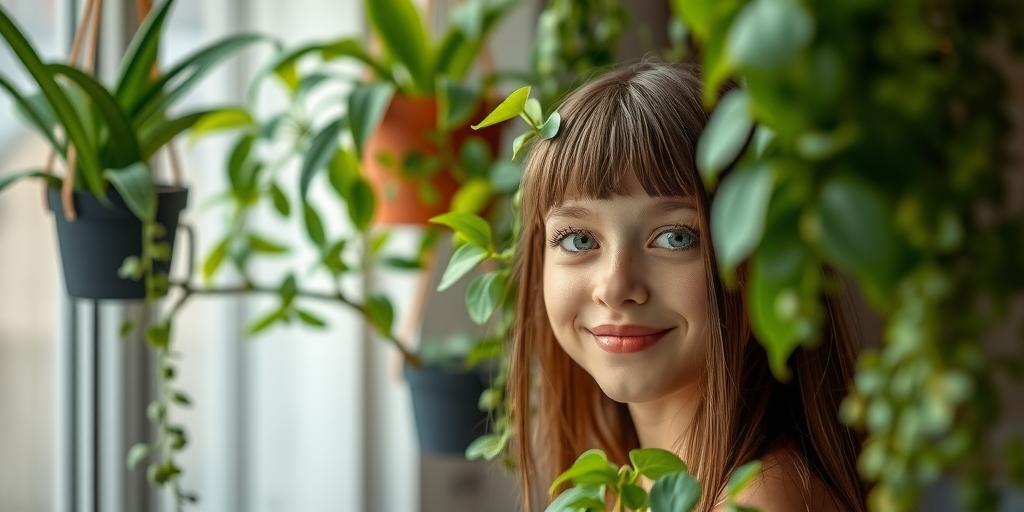
Safe Low Light Hanging Plants for Homes with Pets and Kids (2025)
Looking for pet- and kid-safe hanging plants that thrive in low light? Discover the best non-toxic, easy-care options to beautify your home without compromising safety!
Introduction
Did you know that over 65% of pet owners worry about toxic plants in their homes? If you’re a parent or pet lover, you know how tricky it can be to find greenery that’s both safe and low-maintenance—especially in dimly lit spaces. Hanging plants are a fantastic way to add life to your home without sacrificing floor space, but not all are safe for curious kids and pets. In this guide, we’ll explore the best low-light hanging plants that are non-toxic, durable, and easy to care for, so you can enjoy lush greenery worry-free. Let’s dive in!
Why Choose Pet- and Kid-Safe Hanging Plants?
The Dangers of Toxic Plants for Pets and Small Children
Many common houseplants can be harmful—or even deadly—if ingested by pets or curious toddlers. Plants like pothos, philodendrons, and lilies contain toxins that can cause vomiting, diarrhea, or worse. Dogs and cats, in particular, may chew on leaves out of boredom or curiosity, making it crucial to choose non-toxic varieties.
Hanging plants offer an extra layer of safety by keeping greenery out of easy reach while still adding life to your space.
Benefits of Hanging Plants in Homes with Limited Space
If you live in a small apartment or have limited floor space, hanging plants are a game-changer. They utilize vertical space, freeing up surfaces for other essentials while adding visual interest. Plus, trailing plants create a beautiful cascading effect that can make any room feel more dynamic.
How Low-Light Plants Reduce Maintenance
Not every home gets abundant sunlight, but that doesn’t mean you have to sacrifice greenery. Low-light plants are naturally more adaptable, requiring less frequent watering and minimal direct sun. This makes them ideal for busy households or those new to plant care.
Top 8 Safe Low-Light Hanging Plants for Pet-Friendly Homes
Boston Fern – Lush, Non-Toxic, and Thrives in Humidity
Boston ferns are a classic choice for hanging planters, with their feathery fronds adding a soft, jungle-like vibe. They’re completely safe for pets and love humidity, making them perfect for bathrooms or kitchens. Just keep the soil consistently moist (but not soggy) and mist occasionally.
Spider Plant – Hardy, Air-Purifying, and Safe if Nibbled
Spider plants are nearly indestructible, making them great for beginners. They thrive in indirect light and produce adorable baby “spiderettes” that dangle from the mother plant. Even if your cat takes a curious bite, there’s no need to worry—they’re non-toxic.
Peperomia – Compact, Colorful, and Non-Toxic
With its thick, waxy leaves, peperomia comes in a variety of colors and patterns. These petite plants are perfect for small hanging pots and do well in moderate to low light. Plus, they’re completely safe for pets, so no stress if your furry friend gets too close.
Staghorn Fern – Unique Look, Pet-Safe, and Low-Light Tolerant
Staghorn ferns are epiphytes, meaning they naturally grow on trees rather than in soil. Mounted on a wooden board or placed in a hanging basket, they add a striking, sculptural element to any room. They prefer bright, indirect light but can tolerate lower light conditions.
Parlor Palm – Elegant, Slow-Growing, and Harmless to Pets
Parlor palms bring a touch of tropical elegance without the high maintenance. They grow slowly, making them ideal for long-term hanging displays. Their delicate fronds are safe for pets, and they thrive in low to medium light.
String of Hearts – Trailing Beauty, Safe for Cats and Dogs
This delicate vine with heart-shaped leaves is a showstopper in hanging planters. It trails beautifully and can grow several feet long with proper care. While it prefers bright, indirect light, it can adapt to lower light levels. Best of all, it’s completely pet-friendly.
Baby’s Tears – Delicate Foliage, Perfect for Terrariums
Baby’s tears feature tiny, round leaves that create a lush, cascading effect. They love humidity and do well in terrariums or bathrooms. Though they prefer bright, indirect light, they can survive in lower light with reduced growth.
Cast Iron Plant – Nearly Indestructible and Non-Toxic
True to its name, the cast iron plant is one of the toughest houseplants out there. It can survive neglect, low light, and even dry air. Its broad, dark green leaves add a bold touch to any space, and it’s completely safe for pets.
How to Care for Low-Light Hanging Plants
Best Placement Tips for Optimal Growth
Most low-light hanging plants thrive in bright, indirect light—think near a north-facing window or a few feet away from an east- or west-facing one. Avoid direct sunlight, which can scorch delicate leaves.
Watering Frequency to Prevent Root Rot
Overwatering is the #1 killer of houseplants. Always check the soil before watering—stick your finger an inch deep; if it’s dry, it’s time to water. Ensure your hanging pots have drainage holes to prevent soggy roots.
Safe Fertilizers and Soil Recommendations
Use a well-draining potting mix (like one with perlite or orchid bark) to avoid water retention. For fertilizer, opt for organic, pet-safe options like diluted fish emulsion or worm castings. Apply sparingly during the growing season (spring and summer).
Pruning and Maintenance for Long-Lasting Health
Regularly trim dead or yellowing leaves to encourage new growth. For trailing plants like string of hearts, occasional pruning helps maintain a fuller appearance. Wipe leaves with a damp cloth to keep them dust-free and efficient at photosynthesis.
Common Mistakes to Avoid with Hanging Plants
Overwatering vs. Underwatering Signs
Yellow, mushy leaves? Likely overwatering. Crispy, brown edges? Probably underwatering. Adjust your routine based on the plant’s needs—succulent-like varieties (e.g., string of hearts) need less water than ferns.
Choosing the Wrong Pot or Hanger
Drainage is key! Always use pots with holes, and consider lightweight materials like plastic or fiberglass to avoid strain on hooks. Macramé hangers are stylish but ensure they’re sturdy enough for the plant’s weight.
Ignoring Pest Prevention
Even low-maintenance plants can attract pests like spider mites or mealybugs. Keep an eye out for webbing or sticky residue. For pet-safe pest control, try neem oil spray or wiping leaves with diluted dish soap.
Styling Tips: Incorporating Hanging Plants in Your Home
Best Rooms for Hanging Plants
-
Bathrooms: High humidity-loving plants (like ferns) thrive here.
-
Kitchens: Herbs or trailing plants add freshness near windows.
-
Hallways: Use hanging plants to brighten up narrow, dark spaces.
Creative Hanging Solutions
-
Macramé hangers: Add bohemian charm while keeping plants secure.
-
Ceiling hooks: Ideal for heavier plants like staghorn ferns.
-
Floating shelves: Combine trailing plants with other decor for a layered look.
Pairing Plants for a Lush, Layered Look
Mix textures and lengths—pair a spider plant with a string of hearts for contrast. Grouping different plants at varying heights creates depth and visual interest. Just ensure they have similar light and water needs!
Conclusion
Finding the perfect low-light hanging plants for homes with pets and kids doesn’t have to be stressful! With options like Spider Plants, Boston Ferns, and Peperomias, you can enjoy vibrant, safe greenery without constant upkeep. Ready to transform your space? Start with one of these pet-friendly picks and watch your home come to life—safely and beautifully!
